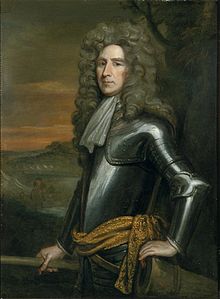The Earl of Romney | |
|---|---|
 | |
| Master-General of the Ordnance | |
| In office 1693–1702 | |
| Lord Lieutenant of Ireland | |
| In office March 1692 – May 1693 | |
| Secretary of State for the Northern Department | |
| In office 1690–1692 | |
| Lord Lieutenant of Kent | |
| In office 1689–1704 | |
| Member of Parliament for Tamworth | |
| In office January 1689 – April 1689 | |
| Envoy to the United Provinces | |
| In office June 1679 – 1681 | |
| Member of Parliament for Bramber | |
| In office July 1679 – January 1681 | |
| Personal details | |
| Born | 1641 Paris |
| Died | 8 April 1704 (aged 63) St James's, London |
| Resting place | St James's Church, Piccadilly |
| Nationality | English |
| Political party | Whig |
| Occupation | Soldier and politician |
| Military service | |
| Years of service | 1678–1694 |
| Rank | Lieutenant General |
| Unit | Colonel, First Foot Guards |
| Battles/wars | Williamite War in Ireland The Boyne; Waterford; First Limerick |
Henry Sydney, 1st Earl of Romney (March 1641 – 8 April 1704) was an English Army officer, Whig politician and peer who served as Master-General of the Ordnance from 1693 to 1702. He is best known as one of the Immortal Seven, a group of seven Englishmen who drafted an invitation to William of Orange, which led to the November 1688 Glorious Revolution and subsequent deposition of James II of England.